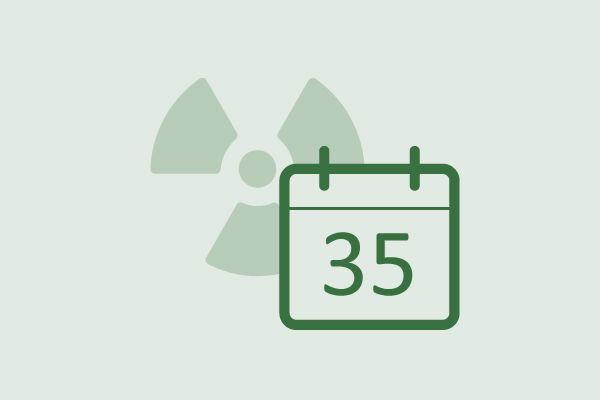35 years of Chernobyl

Measures and consequences to date
On April 26, 1986, a severe accident occurred in the fourth unit of the Chernobyl Nuclear Power Plant in present-day Ukraine (then the USSR). It was the first to be assigned the highest level of 7 on the International Nuclear Safety Inspection Scale (INES). The explosion resulted in a graphite fire, releasing radioactive substances to high altitudes of up to 10,000 meters.
Over 30 deaths are directly related to the nuclear disaster. Reports regarding deaths due to long-term effects of radiation exposure vary widely. Hundreds of thousands of people were evacuated and lost their homes and livelihoods. A 30-kilometer-radius exclusion zone was established and still exists today.
Austria was one of the worst-affected countries in Central Europe. The Chernobyl disaster left a deep mark on the public's consciousness. Many Austrians felt vindicated in their 1978 decision (the Zwentendorf referendum) against the use of nuclear energy for energy.
But it was only the events of 1989 and the perceived threat of nuclear power plants in Austria's immediate neighborhood that led to an active anti-nuclear policy. The social and party-political consensus was finally documented in 1999 by the unanimous decision of the National Council to elevate the Nuclear Ban Act to constitutional status as a federal constitutional law for a nuclear-free Austria.
Measures on the ground – International aid with Austrian participation
In 1995, a "Memorandum of Understanding on the Closure of the Chernobyl Nuclear Power Plant" (MoU) was signed between the G7 countries, the European Commission, and Ukraine. The then Ukrainian President Kuchma pledged to shut down the Chernobyl nuclear power plant by the year 2000, which was done on December 15, 2000. In return, Western support was promised in the energy sector and in nuclear safety, particularly in measures to restore the Chernobyl sarcophagus to an environmentally safe state.
Immediately after the disaster, reactor unit 4 was filled with thousands of tons of lead and sand, and then a temporary structure made of steel and concrete (known as a sarcophagus) was built over it to prevent further release of radioactive material. Because this protective enclosure was constructed in a hurry, the roof threatened to collapse after a few years.
In June 1997, a Shelter Implementation Plan (SIP) was adopted at a G7 meeting. The Chernobyl Shelter Fund (CSF) was established at the European Bank for Reconstruction and Development (EBRD) to finance it. The EBRD itself, the European Commission, and 44 countries made financial contributions. The most important measures were initially the stabilization of the existing sarcophagus and then the construction of the New Safe Confinement (NSC), which was officially handed over to Ukraine in July 2019.
Based on its own experience of the disaster, but also out of solidarity with Ukraine, Austria has been actively involved in the Chernobyl Shelter Fund (CSF) from the very beginning. With a contribution of 13 million euros toward the approximately 2 billion euros total costs, Austria is one of the larger donors among the smaller non-G7 countries.
Consequences of the disaster – International conventions and efforts to improve nuclear safety
Internationally, the Chernobyl disaster led to a series of conventions under the auspices of the International Atomic Energy Agency (IAEA). This created, for the first time, a legally binding set of rules under international law, albeit without sanctions.
In the same year, the International Convention on Early Notification of a Nuclear Accident and on Assistance in the Case of a Nuclear Accident or Radiation-Related Emergency was concluded. The Convention on the Physical Protection of Nuclear Material was adopted in 1989, and the Convention on Nuclear Safety in 1998. The Convention on the Safe Management of Radioactive Waste and Spent Fuel entered into force in 2001. Austria is a party to all of these conventions.
The Chernobyl disaster, as well as other recent events such as the Fukushima disaster, have led to significant efforts to improve nuclear safety, both within the legal framework and within the nuclear power plants themselves – although not enough. However, the safest nuclear power plant is still the one that is never built. Until then, however, serious accidents in nuclear power plants cannot be ruled out. These commemoration days should serve as a warning.
The Federal Ministry for Climate Action has launched an information campaign on myths surrounding nuclear power. These myths are discussed and refuted in detail in the fact sheets.
Fact Sheets
The following fact sheets are also available in German!
- Fact Check new: Triple Pledge, Empty Promise? (PDF, 337 KB)
- Fact Check: Nuclear Power’s Share in Electricity Generation Continues to Fall (PDF, 149 KB)
- Fact Check: The Triumph of Renewable Energies (PDF, 205 KB)
- Fact Check: No Signs of a Nuclear Renaissance (PDF, 288 KB)
- Fact Check: New Nuclear Power and the Climate Emergency (PDF, 179 KB)
- Fact Check new: Nuclear Power and War (PDF, 114 KB)
- Fact Check: Nuclear Terrorism: “Most Immediate and Extreme Threat to Global Security” (PDF, 111 KB)
- Fact Check: The Power Plant and the Bomb – Nuclear Energy’s Siamese Twins (PDF, 116 KB)
- Fact Check new: Can nuclear power deliver security of supply and energy independence? (PDF, 127 KB)
- Fact Check new: Potential Nuclear Newcomer Countries (PDF, 120 KB)
- Fact Check: Small Modular Reactors – The Power of Promise (PDF, 137 KB)
- Fact Check new: Generation IV reactors (PDF, 104 KB)
- Fact Check: Renewables More Reliable Than Ageing Nuclear Power Plants? (PDF, 357 KB)
- Fact Check: Safety Implications of Lifetime Extensions (PDF, 261 KB)
- Fact Check: Cost Implications of Lifetime Extensions (PDF, 165 KB)
- Fact Check: Nuclear and Coal Phaseout – Can It Be Done? – The German Case (PDF, 144 KB)
- Fact Check new: Nuclear Economics and Finance (PDF, 258 KB)
- Fact Check: Nuclear Waste – An Intergenerational Issue (PDF, 105 KB)
- Fact Check: Fukushima – Not a Worst-Case Even (PDF, 248 KB)